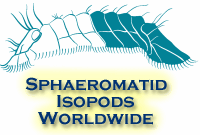| Abstract |
The isopod family Bopyridae comprises 469 described species, all of them ectoparasites of the decapod crustaceans; it accounts for at least 80% of all species of its suborder, the Epicaridea. The family is divided into ten subfamilies, each of which is largely restricted to hosts belonging to a single decapodan infraorder or lower taxon. The most primitive subfamily is Pseudoioninae, members of which probably first infested anomurans of the family Galatheidae. All other subfamilies are derivable from the Pseudioninae, soe through a seris of genera infesting thalassinideans and designated the Thalassinidean Transition. Evidently the two major subfamilies of abdominal parasites arose separately. The center of distribution and probably origin of Bopyridae is the tropical Indo-West Pacific, with progressively fewer species being found westward to the eastern Pacific. Most subfamilies follow this overall pattern, but some deviate markedly from it.>
<Stone age biogeography, but a few interesting possibilities such as host specificity which may be useful for host parasite coevolution studies. Has a useful table of suspected fossil bopyrid evidence, earliest being Jurassic age. List of subfamilies and species in each.
[BIOGEOGRAPHY; BOPYRIDAE; DIVERSITY; EPICARIDEA; EVOLUTION; INDO-PACIFIC; ISOPODA; PARASITES; ZOOGEOGRAPHY] |

















